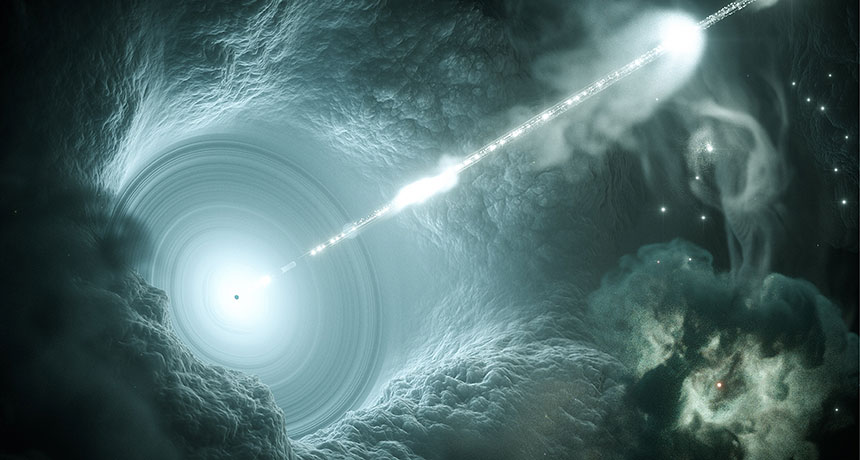It looks like you're using an Ad Blocker.
Please white-list or disable AboveTopSecret.com in your ad-blocking tool.
Thank you.
Some features of ATS will be disabled while you continue to use an ad-blocker.
16
share:
Interesting and thought to share, what goes on above is truly amazing and we do not yet know 99% of It ?

www.sciencenews.org...

HOME BASE Scientists traced a high-energy neutrino back to its source: a blazar, a galaxy harboring a supermassive black hole that fuels powerful jets of particles.
A zippy little particle has been traced back to its cosmic stomping grounds, a flaring galaxy 4 billion light-years away, for the first time solving a cosmic whodunit. Scientists have long puzzled over the sources of high-energy particles from space, which batter the Earth at energies that can outstrip the world’s most advanced particle accelerators. Now, physicists have identified the source of an energetic, lightweight particle called a neutrino. The intergalactic voyager came from a type of bright galaxy called a blazar located in the direction of the constellation Orion, scientists report online July 12 in Science.
“This is super exciting news,” says astrophysicist Angela Olinto of the University of Chicago, who was not involved with the new result. “It’s marking the beginning of what we call neutrino astronomy,” which uses the nearly massless particles to reveal secrets of cosmic oddities like blazars. While there may be additional cosmic sources for high-energy neutrinos, the detection indicates that at least some come from blazars. The result also suggests that blazars emit other energetic particles known as cosmic rays, which are produced in tandem with neutrinos. The origins of high-energy cosmic rays are poorly understood and until now, “nobody has ever been able to pinpoint a source that produces them,” says astrophysicist Francis Halzen of the University of Wisconsin–Madison, a leader of IceCube, the Antarctic neutrino observatory that detected the particle.
www.sciencenews.org...
edit on 12 7 2018 by skywatcher44 because: Add
a reply to: skywatcher44
Since I was little I have been fascinated by space and what is out there. I love things like this. It makes my mind go a mile a minute with wonder. We really have no idea what really goes on in space or the universe so things like this are a cool find.
Since I was little I have been fascinated by space and what is out there. I love things like this. It makes my mind go a mile a minute with wonder. We really have no idea what really goes on in space or the universe so things like this are a cool find.
new topics
-
President BIDEN's FBI Raided Donald Trump's Florida Home for OBAMA-NORTH KOREA Documents.
Political Conspiracies: 2 hours ago -
Maestro Benedetto
Literature: 4 hours ago -
Is AI Better Than the Hollywood Elite?
Movies: 4 hours ago -
Las Vegas UFO Spotting Teen Traumatized by Demon Creature in Backyard
Aliens and UFOs: 8 hours ago -
2024 Pigeon Forge Rod Run - On the Strip (Video made for you)
Automotive Discussion: 8 hours ago -
Gaza Terrorists Attack US Humanitarian Pier During Construction
Middle East Issues: 9 hours ago -
The functionality of boldening and italics is clunky and no post char limit warning?
ATS Freshman's Forum: 10 hours ago -
Meadows, Giuliani Among 11 Indicted in Arizona in Latest 2020 Election Subversion Case
Mainstream News: 10 hours ago -
Massachusetts Drag Queen Leads Young Kids in Free Palestine Chant
Social Issues and Civil Unrest: 11 hours ago
16
